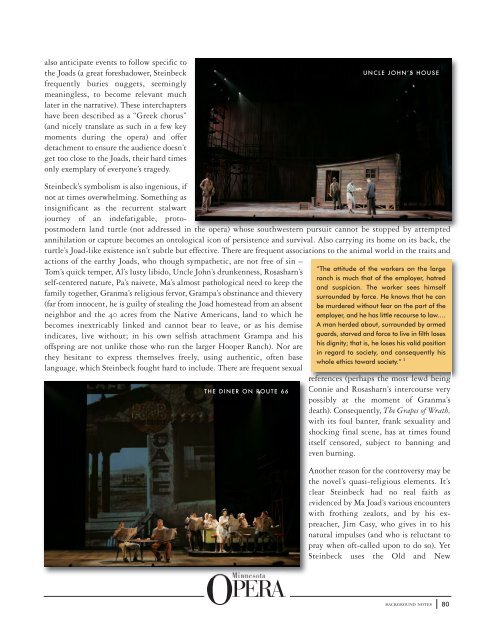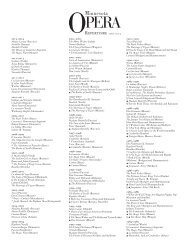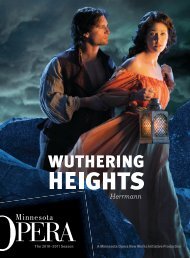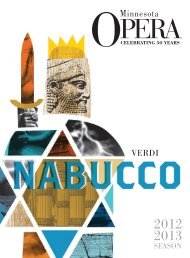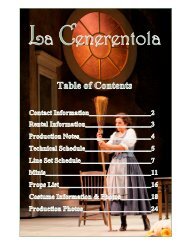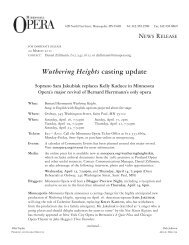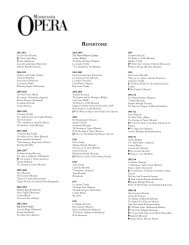Create successful ePaper yourself
Turn your PDF publications into a flip-book with our unique Google optimized e-Paper software.
also anticipate events to follow specific to<br />
the Joads (a great foreshadower, Steinbeck<br />
frequently buries nuggets, seemingly<br />
meaningless, to become relevant much<br />
later in the narrative). These interchapters<br />
have been described as a “Greek chorus”<br />
(and nicely translate as such in a few key<br />
moments during the opera) and offer<br />
detachment to ensure the audience doesn’t<br />
get too close to the Joads, their hard times<br />
only exemplary of everyone’s tragedy.<br />
UNCLE JOHN’S HOUSE<br />
Steinbeck’s symbolism is also ingenious, if<br />
not at times overwhelming. Something as<br />
insignificant as the recurrent stalwart<br />
journey of an indefatigable, protopostmodern<br />
land turtle (not addressed in the opera) whose southwestern pursuit cannot be stopped by attempted<br />
annihilation or capture becomes an ontological icon of persistence and survival. Also carrying its home on its back, the<br />
turtle’s Joad-like existence isn’t subtle but effective. There are frequent associations to the animal world in the traits and<br />
actions of the earthy Joads, who though sympathetic, are not free of sin –<br />
Tom’s quick temper, Al’s lusty libido, Uncle John’s drunkenness, Rosasharn’s<br />
self-centered nature, Pa’s naivete, Ma’s almost pathological need to keep the<br />
family together, Granma’s religious fervor, Grampa’s obstinance and thievery<br />
(far from innocent, he is guilty of stealing the Joad homestead from an absent<br />
neighbor and the 40 acres from the Native Americans, land to which he<br />
becomes inextricably linked and cannot bear to leave, or as his demise<br />
indicates, live without; in his own selfish attachment Grampa and his<br />
offspring are not unlike those who run the larger Hooper Ranch). Nor are<br />
they hesitant to express themselves freely, using authentic, often base<br />
language, which Steinbeck fought hard to include. There are frequent sexual<br />
THE DINER ON ROUTE 66<br />
“The attitude of the workers on the large<br />
ranch is much that of the employer, hatred<br />
and suspicion. The worker sees himself<br />
surrounded by force. He knows that he can<br />
be murdered without fear on the part of the<br />
employer, and he has little recourse to law.…<br />
A man herded about, surrounded by armed<br />
guards, starved and force to live in filth loses<br />
his dignity; that is, he loses his valid position<br />
in regard to society, and consequently his<br />
whole ethics toward society.” 2<br />
background notes 80<br />
references (perhaps the most lewd being<br />
Connie and Rosasharn’s intercourse very<br />
possibly at the moment of Granma’s<br />
death). Consequently, The <strong>Grapes</strong> of Wrath,<br />
with its foul banter, frank sexuality and<br />
shocking final scene, has at times found<br />
itself censored, subject to banning and<br />
even burning.<br />
Another reason for the controversy may be<br />
the novel’s quasi-religious elements. It’s<br />
clear Steinbeck had no real faith as<br />
evidenced by Ma Joad’s various encounters<br />
with frothing zealots, and by his expreacher,<br />
Jim Casy, who gives in to his<br />
natural impulses (and who is reluctant to<br />
pray when oft-called upon to do so). Yet<br />
Steinbeck uses the Old and New


